Ap Statistics Unit 1 Test Review Problems Day 1
Are you worried nearly passing the AP® Statistics Exam? You're in the right place. We wrote this comprehensive AP® Statistics study guide so y'all can master the concepts and walk into the test with confidence.
In this review guide, we'll go over key questions you may have most the exam, how to study for AP® Statistics, every bit well every bit what AP® Statistics review and do resources to use equally you begin preparing for your exam.
Allow's get started!

What's the Format of the 2022 AP® Statistics Examination?
The AP® Statistics exam includes 40 multiple-choice questions and 6 free-response questions, including ane Investigative Task; the Investigative Task is merely a challenging free-response question that applies the textile to a new context.
| Department | # of Questions | Time Limit | % of Overall Score |
| Department I: Multiple Choice | twoscore MCQs | ninety minutes | 50% |
| Section II Part A: Gratuitous Response | v FRQs | 65 minutes | 37.five% |
| Section Ii Function B: Investigative Task | 1 Investigative Task | 25 minutes | 12.5% |
Source: CollegeBoard
Render to the Tabular array of Contents
How Long is the AP® Statistics Test?
The AP® Statistics exam is three hours long. Students will take ninety minutes to consummate the multiple option section (40 questions) and ninety minutes to complete the free response section (6 questions).

What Topics are Covered on the AP® Statistics Exam?
AP® Statistics Topics Overview
Here is an overview of the topics that will exist covered on the AP® Statistics Exam, along with resources that tin can be used to review each unit of measurement.
| Unit of measurement | Topics | Resources |
| Unit 1: Exploring I-Variable Data |
| Exploring Categorical and Numerical Information Normal Distributions Key Vocab and Questions Albert Exercise Questions: Unit of measurement 1 |
| Unit of measurement 2: Exploring 2-Variable Data |
| Examining Relationships: scatterplots, correlation, LSRL Transforming the Data Central Vocab and Questions Albert Practice Questions: Unit 2 |
| Unit 3: Collecting Data |
| Taking Samples and Designing Experiments Cardinal Vocab and Questions Albert Practise Questions: Unit iii |
| Unit 4: Probability, Random Variables, and Probability Distributions |
| Probability notes Discrete, Binomial & Geometric Random Variables Transforming and combining Random Variables Albert Practice Questions: Unit 4 |
| Unit 5: Sampling Distributions |
| Sampling Distributions – Dan Shuster one-folio summary Sampling Distributions – Holloman'south notes Key Vocab and Questions Albert Practice Questions: Unit 5 |
| Unit six: Inference for Chiselled Data: Proportions |
| These resources combine topics from Unit six and Unit 7: Introduction to Inference Estimating with Conviction Testing a Claim Comparing 2 populations or groups Albert Practise Questions: Unit half-dozen |
| Unit of measurement vii: Inference for Quantitative Information: Means |
| Albert Practise Questions: Unit 7 |
| Unit 8: Inference for Categorical Data: Chi-Foursquare |
| Chi-Foursquare Testing Detailed notes and examples Albert Practice Questions: Unit of measurement viii |
| Unit ix: Inference for Quantitative Data: Slopes |
| Inference for linear regression Albert Exercise Questions: Unit 9 |
Source: AP® Statistics: The Course at a Glance
Now we will show you how the topics are distributed amongst each department of the test.
Department I: Multiple Choice
The multiple choice department is worth half of the exam score and addresses the nine units of AP® Statistics with the following weights:
| Units | Exam Weighting for MC Questions |
| Unit of measurement ane: Exploring I-Variable Data | fifteen-23% |
| Unit 2: Exploring Two-Variable Information | 5-7% |
| Unit 3: Collecting Information | 12-fifteen% |
| Unit of measurement 4: Probability, Random Variables, and Probability Distributions | x-20% |
| Unit five: Sampling Distributions | seven-12% |
| Unit 6: Inference for Categorical Data: Proportions | 12-xv% |
| Unit 7: Inference for Quantitative Data: Ways | 10-xviii% |
| Unit of measurement 8: Inference for Categorical Data: Chi-Square | 2-5% |
| Unit of measurement 9: Inference for Quantitative Data: Slopes | 2-5% |
Source: Higher Lath
That means you tin can focus the majority of your study on the following:
- Units i and 2: Exploring data with graphs and summary statistics (twenty-xxx%)
- Units 4 and five: Probability, random variables, and distributions (xx-30%)
- Units six and 7: Inference for proportions and means (22-33%)
But studying these topics could encompass up to xc% of the multiple choice section! To put that into context, in 2012 , whatever pupil who scored between 70 and 100 earned a five on the AP® Statistics Exam. That means that by studying the correct topics, you could earn a 5 on the AP® Statistics Exam past skipping three units entirely (although nosotros don't recommend skipping any units, for obvious reasons)!
Section Ii: Gratis Response
Like the multiple option section, the free response section is worth half the exam score and often combines several skills into a unmarried question.
The five standard complimentary-response questions in Part A volition include:
- Ane question with a principal focus on Collecting Data and Selecting Statistical Methods
- I question with a primary focus on Exploring Information and Data Analysis
- One question with a primary focus on Probability and Sampling Distributions with Simulations
- One question with a primary focus on Inference
- I question that focuses on two or more skill categories
The investigative task (Part B) will appraise multiple topics and skills, focusing on the application of skills and content in new contexts or in non-routine ways.
Return to the Table of Contents
What Do the AP® Statistics Test questions Look Like?
The College Board has released two total AP® Statistics Exams: 2012 AP® Statistics Exam and 1997 AP® Statistics Examination . Because they frequently reuse multiple choice questions, they limit the number of full official tests they brand public (you can supplement this with full-length practice exams from Albert ). For free response questions, College Board has released xx years of official AP® questions to be used for do and review. Hooray!

Multiple Choice Examples
Here are some of the nearly mutual questions you volition run across on the exam, with tips and tricks to make sure you get them right on test twenty-four hour period.
#one: Deciphering a graph (usually a histogram, boxplot, or scatterplot)
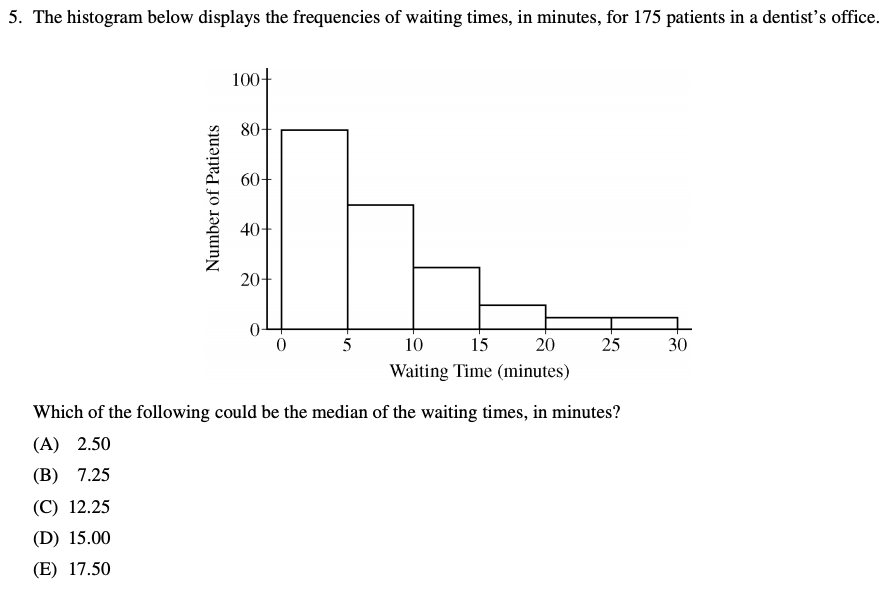
CollegeBoard 2012 AP® Statistics Exam #five
Agreement visual and numerical descriptions of data, including histograms and measures of eye like median, are cardinal parts of the AP® Statistics curriculum; they are such vital topics that they are covered in Unit i! In this question, the creators of the examination intentionally provide a skewed data fix (one that is non symmetric) to appraise your understanding of mean vs. median. Wait at the "tail" on the correct side of this histogram. That ways the median (middle data betoken) has to be much lower than the mean (average calculated value).
What makes this even more tricky is a lack of existent information points, so it is incommunicable to answer this question by plugging values into a estimator. You lot need to infer the location of the median using the sample size of 175 and finding the bar where the 88th (middle number) patient sits. While many are tempted to choice the "heart" of the graph around xv, the median value is actually between 5 and x minutes. The answer is B, the simply value in that range. You are sure to detect questions like this on the test; exist on the lookout for graphs that are skewed and do not expect symmetric or normal .
#2: Which formula is right?
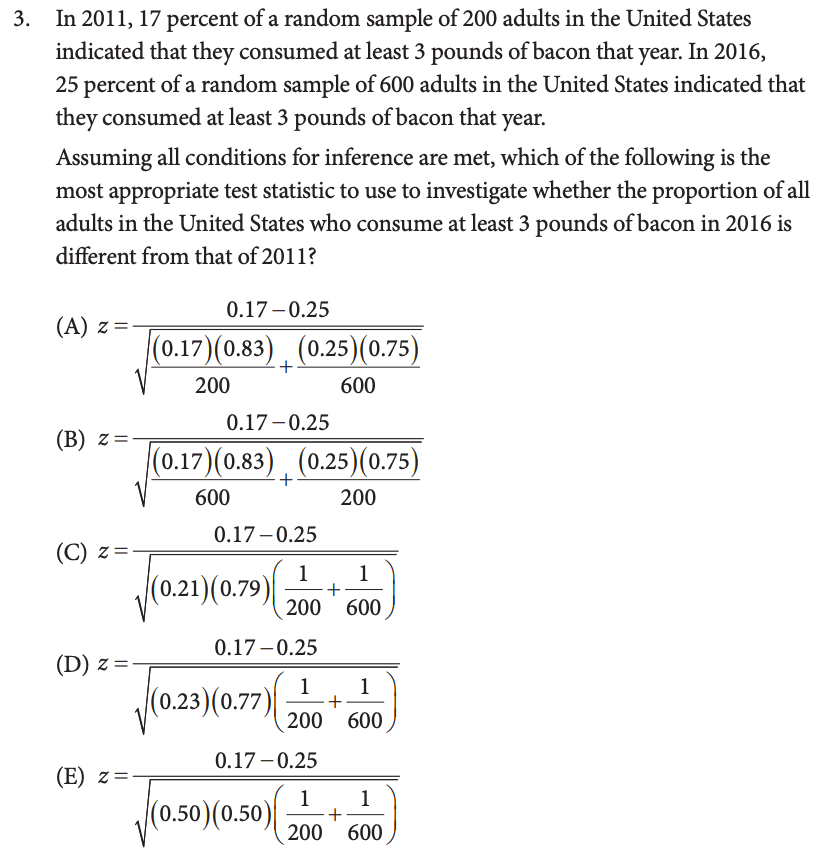
CollegeBoard 2019 AP® Statistics Course Description – MC Example #three
This question proves that a formula canvas is non necessarily your aureate ticket to a v. While you are provided a formula sail for the test, the writers for the AP® Statistics Exam need to know that you tin practice more than plug-and-chug numbers. They want to know if yous empathise when and how to use each formula. This problem is a perfect example of how they might assess your noesis of two-sample proportions and null hypotheses.
At outset glance, you run across that y'all have two groups to compare, where \lid{p}_1=0.17, n_1=200, \hat{p}_2=0.25, and n_2=600. With just those numbers and your trusty formula sheet , it might be tempting to pick A… simply, look!
You need to remember that this exam has the cipher hypothesis: p_1=p_2! That means we perform calculations nether the assumption that the two groups are equal, or that the nix is true. So, you demand to combine the 2 samples (with 34 and 150 successes out of a total 800 adults) to discover a combined proportion of success \chapeau{p}_c=0.23. Then, and but then, you tin plug your values into the appropriate formula. The answer is D.
#3: Interpreting a confidence interval

CollegeBoard 2012 AP® Statistics Exam #22
Any calculator or estimator can churn out a conviction interval. Information technology takes a existent statistician to be able to interpret that information into an intelligible format. This is a classic question that assesses your understanding of "conviction interval", a term based on repeated sampling to capture the true parameter. The 95% here refers to the percentage of samples that are successful in covering the true mean, non the percentage of students or hours. Therefore, the reply is B.
This type of question appears over again and over again on AP® Statistics, and you lot will be asked to interpret other statistical terms like P-values, slopes of regression models, correlation coefficient r, z-scores, and more ! It isn't plenty to memorize key words and phrases. You demand to really understand what they stand for in the context of the situation. Incorporate some wink cards into your written report routine to really solidify your understanding of statistical terms and brand this vocabulary 2d nature.

Return to the Tabular array of Contents
Complimentary Response Examples
We'll also bear witness you a few complimentary response questions and intermission down the grading rubrics ( case rubric from 2018 ) so that you can strategically tackle this department of the test.
The scoring guidelines have remained the same since 1999. Each part of the question is scored with an E (essentially correct), P (partially correct), or I (incorrect). The combination of letter grades for each part will decide your composite numerical grade for the question: 1 (minimal response), 2 (developing response), 3 (substantial response), or four (complete response).
#1: Comparing two populations
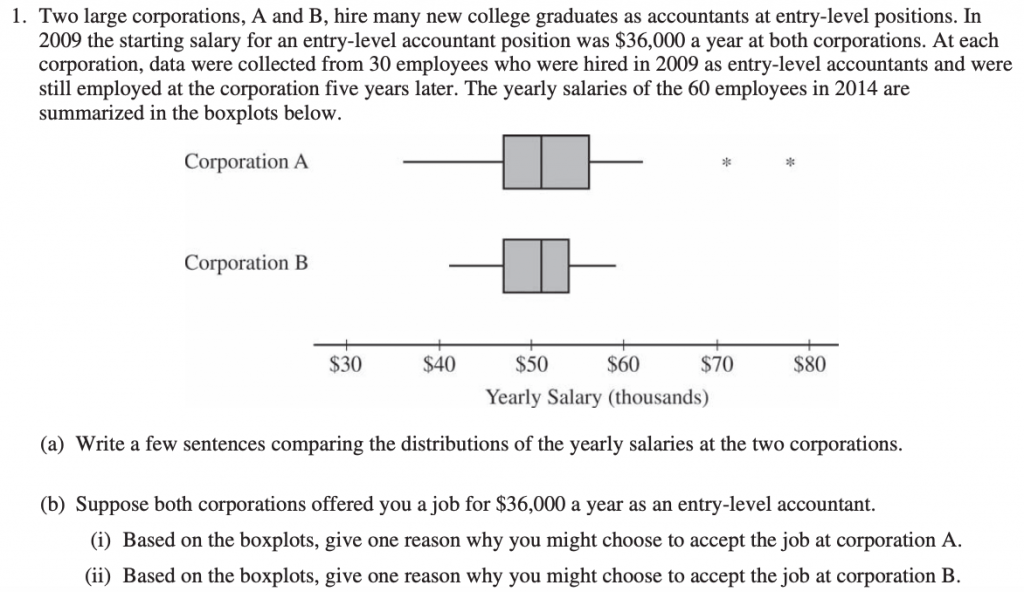
College Board 2015 AP® Statistics Exam #i
In this multi-part problem, you are asked to compare the salary distributions of ii corporations based on their boxplots.
Quick tip: touch all key features of the graphs using the acronym SOCS: shape, outliers, center, and spread. By talking almost these features in context of the trouble , you would be on runway to earning an East (essentially right) for office (a).
Here is a snapshot from the scoring guidelines for part (b):
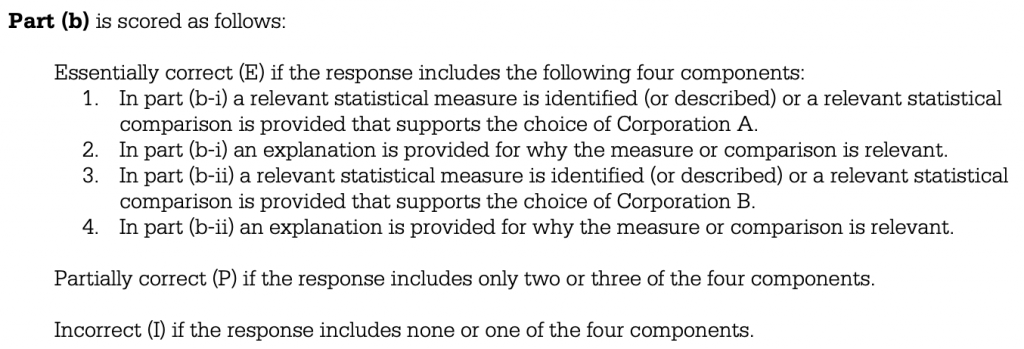
College Board 2015 Gratis Response Scoring guidelines
The of import words here are "statistical measure out", significant y'all must specifically reference values like the median in Corporation B or the outliers in Corporation A. You can ever refer to SOCS for ideas on relevant statistical measures to employ!
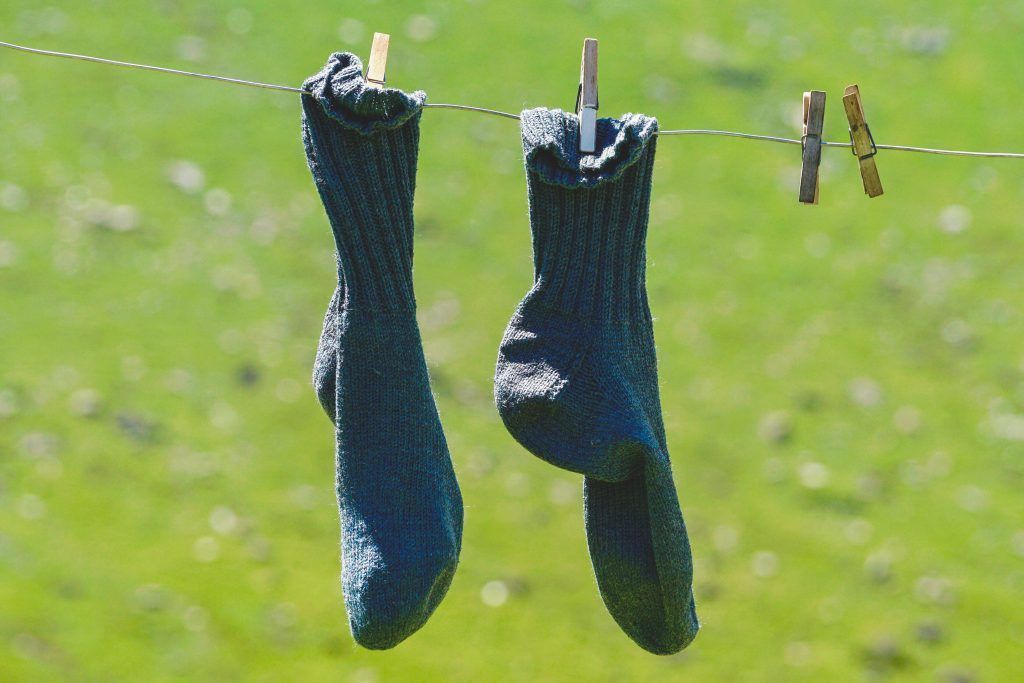
#2: Running a Total Inference Procedure
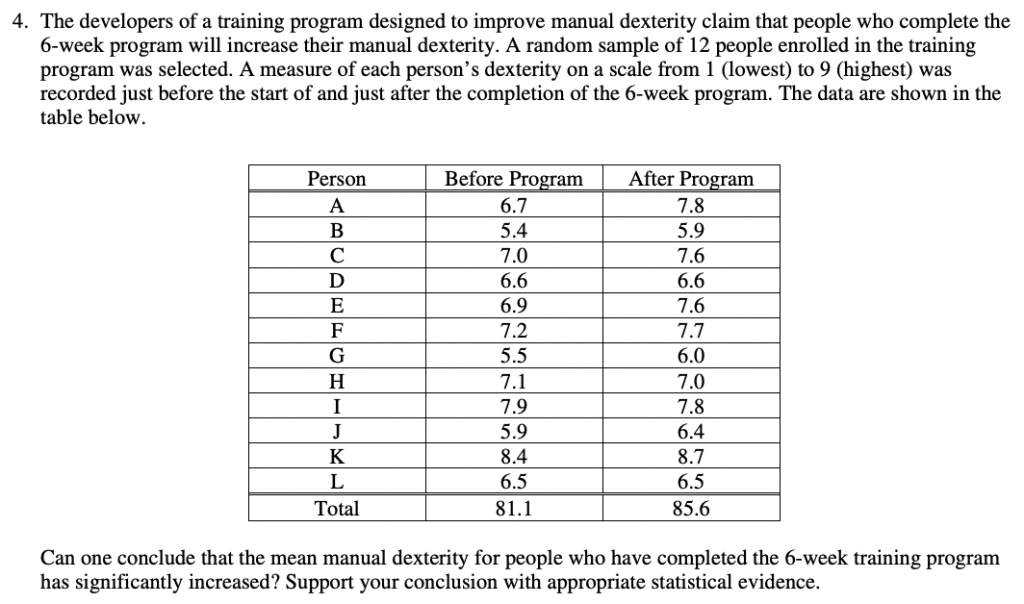
College Board 2006 AP® Statistics Exam Form B #4
Many students volition get this problem incorrect by accidentally running a two sample t-test instead of a matched pairs t-test. What they fail to recognize is that the 2 groups (earlier and after) are dependent on the person, thus matched up! If yous need practice identifying statistical methods, try this interactive applet on Classifying Statistics Problems .
Afterward ID-ing the test method, the remainder involves plugging the values into your calculator to become the paired differences and the mean + standard difference for that sample.
The 2006 Class B scoring guidelines details the fours steps that are necessary for every hypothesis test you lot run:
- State the correct hypotheses
- Place test name and cheque for weather condition
- Summate the exam statistic and P-value
- Conclude in context
By correctly following that 4-step process for hypothesis tests, you will check off all the boxes en route to earning your perfect score!
#3: Investigative Task – Multiple linear models
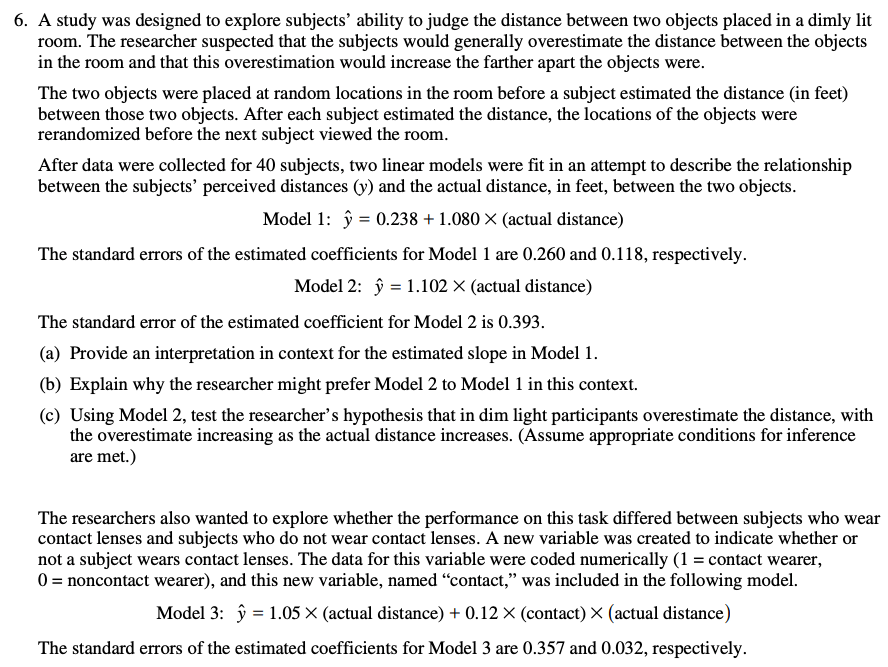
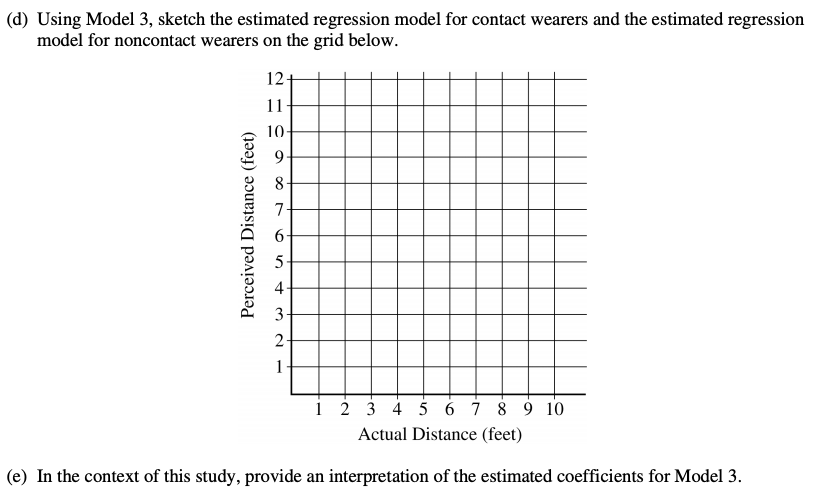
College Lath 2007 AP® Statistics Examination #6
Just based on length alone, you can tell that the Investigative Task is significantly longer than other gratis response questions. Luckily, you are budgeted more time (25 minutes) to parse through the question and deliver a quality response.
Quick tip: Many students plan to tackle the Investigative Task first in order to guarantee it gets done in time and isn't a source of stress at the end of the test!
This problem demands a deep understanding of linear regression, dummy variables, and abstract thinking almost the interaction of multiple variables. Looking at the scoring guidelines , you tin can see a focus on clear communication rather than long computations. So make sure to explain all your thinking and provide detailed explanations of your answers.

Return to the Tabular array of Contents
What Tin can You Bring to the AP® Statistics Exam?
These guidelines will help you nail down what to bring to the AP® Statistics Examination, and besides what Non to bring! We recommend packing your handbag the nighttime earlier and then you tin relax the morning of the exam.
Do bring these:
- No. ii pencils and erasers
- Pens with black or dark blueish ink
- A graphing calculator with statistical capabilities (meet full AP® Statistics Calculator Policy )
- A current government-issued or schoolhouse-issued photo ID
- Your College Board SSD Accommodations Alphabetic character (if you are taking an exam with approved testing accommodations)
- A spotter that does not have net access and does not make noise
DO Not bring these:
- Food or drink, including bottled water
- Whatsoever electronic equipment or communication devices, including:
- Phones, smartwatches, or wearable technology of any kind
- Laptops or tablet computers
- Bluetooth devices
- Portable listening or recording devices such as MP3 players and iPods
- Cameras or other photographic equipment
- Devices that can access the internet
- Separate timers of any type
- Whatever other electronic or communication devices
- Your own crook sheet (a formula sheet volition be provided)
Render to the Table of Contents
How to Study for AP® Statistics: 7 Steps
To ensure thorough and effective review for the AP® Examination, information technology will take twenty+ hours to complete all 7 steps listed below. Be sure to pace yourself when studying for your AP® Stats exam, and study for no longer than 2 hours at a time. You can cycle through steps 4 – six as many times as you experience is necessary to principal the textile and develop conviction with the exam.
1. Take a total diagnostic test (three hours)
Time yourself to go a sense of pacing for each section, and take note of any topics or sections that give yous trouble. Yous can use the official released College Lath exam from 2012 , have a do examination from Albert online, or purchase a review book from Barron'southward or The Princeton Review .
2. Grade your exam and prioritize topics that you need to do (1 – 2 hours)
Y'all should take your time in this self-assessment piece to actually brand the most of your study sessions. Read carefully through the gratis response scoring guidelines while grading yourself, even reading the notes and alternative solutions.
After, become through the topics list and highlight each item based on your level of agreement: green if you lot are highly confident in that topic, yellow if you are shut to mastery, and pink for topics that y'all need to review and practice.
3. Map out study sessions in your calendar (xx min)
Notice out how many days you have earlier the AP® Statistics Examination twenty-four hours, and block out fourth dimension each 24-hour interval for review. Fifty-fifty if you only review for 15 minutes a twenty-four hour period, that is better than eight hours of cramming the dark earlier the exam. If y'all tin, find a partner to join you for your study sessions!
"Success is the sum of small efforts – repeated day in and day out." – Robert Collier
iv. Re-learn tricky concepts with notes and videos (2 – 5 hours)
Await through summary pages in your textbook or review material from online resources, focusing on trickier topics you identified to a higher place. Mr. Holloman'south AP® Statistics , Dan Shuster Chapter Notes , and YouTube videos by Rob Tarrou are all keen resources to aid you clarify concepts y'all may have missed the showtime time effectually.
5. Do do problems. And then do some more. (10 – 15 hours)
This is arguably the about important slice of the puzzle. Yous should practice sample questions from isolated topics and get detailed feedback on correct + wrong answers.*
Yous can selection and cull questions from released AP® Statistics Exams or AP® Statistics Review Books and build up your mental "bank" of official questions.
*An important role of this procedure is checking your answers and reading through the solutions advisedly. If you tin clear WHY you lot got an answer wrong and how your understanding of the topic has changed, you volition be well on your way to acing the AP® Statistics Exam.

6. Take another full test under time pressure level (3 hours)
Put your newfound knowledge to the test with another total exam, paying careful attending to time direction equally y'all movement through each department. Yous should budget about 2 minutes per multiple choice problem, 13 minutes for each regular free response, and 25 minutes for the Investigative Task. Afterwards, reflect on where you felt comfortable and rushed, and figure out exam sections that you may need to study up or salvage for terminal. For example:
- Do you run out of time when completing an Investigative Task? (We recommend doing this second in the free response section)
- Are yous losing time typing numbers into your reckoner for regression or graphical displays?
- Are y'all spending too long on multiple choice problems involving probability calculations?
Knowing your strengths and weaknesses can aid you make a plan for test day so that you walk in feeling confident and fully prepared.
seven. Residuum up the day earlier the test! (5 hours)
Cycle through steps #4-half-dozen as many times as you can during your study sessions, but leave the day before the exam for some relaxation and self-care. Go conditioning, meditate, hang out with friends, eat nutritious nutrient, do some light review with flashcards, and most chiefly… get a good nighttime's sleep !
*It tin can even be helpful to program something fun afterwards the exam to celebrate finishing AP® Stats. Grab ice cream with friends or treat yourself to a nap in the hammock!

Return to the Table of Contents
AP® Statistics Review: 15 Must Know Study Tips
5 AP® Statistics Study Tips to Exercise at Home
1. Break upward your report sessions into chunks using the Pomodoro Technique .
The classic model involves setting a timer and studying for 25 min sessions with a five min break in betwixt each session. Y'all can accept a longer (30 min) break later on iv sessions to proceed your listen fresh and productive. This volition truly make the study sessions fly by!
2. Get to know your reckoner and the common functions for statistics, such as pnorm, binompdf, calculating confidence intervals, and running regression models.
Hither is a great summary page of Calculator Functions for the AP® Stats Exam . This will help you save enormous fourth dimension on the multiple choice section and bank check your answers in the free response.
3. Practice classifying statistical inference procedures using your textbook or this applet on Classifying Statistics Issues .
Bank check out Stats Medic's article Proper noun that Significance , or this great flowchart of inference from StatsMonkey for a visual representation of when to implement each exam or confidence interval.
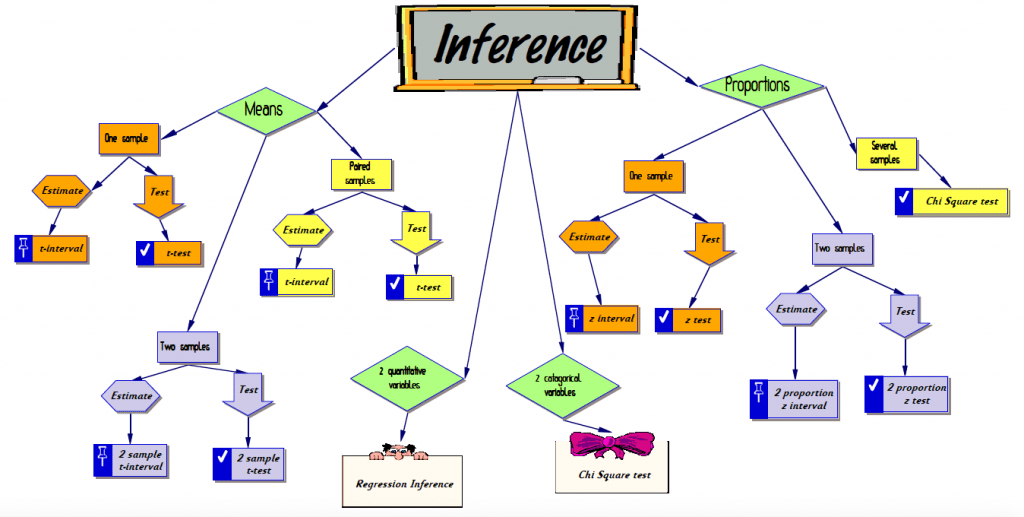
Source: StatsMonkey Inference Inspiration
4. Part of your studying can be annotating the AP® Statistics formula sheet and then that you lot know which formulas to employ for specific topics.
Instead of memorizing things that are already provided to you, you should reference each practice problem to a formula on the sheet (when applicable) and make a mental map of the cheat sheet, like this professor does for certain equations . It is a like process to annotating a book for close reading, where you write your own thoughts and opinions in the margins to assistance process and retain data.
5. Practise, do, practice.
Reading your textbook and gaining knowledge is one thing; putting that knowledge to the examination with challenging do questions is another. As soon equally possible, start doing multiple choice and gratuitous response questions from College Lath , Albert , or AP® Statistics Review Books . Nosotros hope that you make mistakes and learn from them. Utilize your teachers and peers for help when you get stuck, then do as many practice problems as y'all can to build cognition and confidence.
"Don't practice until you go it right. Practice until y'all tin't go information technology wrong."
five AP® Statistics Multiple Selection Tips
i. Reply every question, even if you have to guess.
You lot don't lose points for wrong answers, then before yous give upward on a question completely, use the procedure of elimination to dominion out unlikely answers and make an educated judge. NEVER leave a question bare; the aforementioned goes for any free response questions, where you lot might earn partial credit for a formula that is jotted downwardly correctly.
2. Focus the bulk of your studying on the topics that are more than likely to appear on the exam:
For example, these topics announced the near in the multiple option section.
- Inference for proportions and means (22-33%)
- Exploring data with graphs and summary statistics (20-30%)
- Probability, random variables, and distributions (20-30%)
Other topics like experimental design, linear regression, and chi-foursquare testing volition show up on the examination, simply at a much lower frequency than those listed above.
3. Draw sketches of the distributions whenever possible, turning exact descriptions into visual displays that yous can interpret.
This is particularly useful when it comes to calculating probabilities (with Venn diagrams or normal distributions), finding summary statistics for skewed distributions, and envisioning trends in scatterplots.

four. Practice identifying binomial variables such as a money flip, gratuitous throw, or any random result involving: 1) repeated trials, 2) two possible outcomes, 3) a fixed probability of success, and 4) contained trials.
This is a very specific probability topic that can save y'all valuable fourth dimension when you lot recognize information technology and speedily calculate the answer using binompdf in your calculator.
5. Read the questions completely— no skimming.
Fifty-fifty with longer descriptions of experimental designs or hypothesis test interpretations, brand sure to read each judgement thoroughly and empathise the scenario earlier looking at the answers. Some of the "distractor" answers accept subtle differences that are designed to appear plausible but that really exploit common misconceptions.

5 AP® Statistics Free Response Tips
1. Know the language of statistics and use common phrases similar "on average", "predicted increase", or "sufficient evidence to refuse the null".
Here is an excellent handout of the Summit x Phrases to use in your Answers for AP® Statistics
2. Label everything, including graphs, formulas, random number tables, and sketches of normal distributions.
You don't desire to lose points for lack of communication, and clear labels volition continue your thoughts organized while giving y'all a shot at partial credit. This goes forth with tip #3…
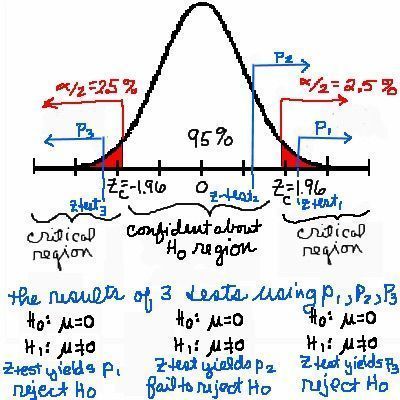
Source: mathnstuff
three. Explain all of your answers thoroughly and in context!
You will receive no credit for "naked answers" on the examination, even if the numbers are right (this is a common mistake on probability questions). Provide detailed explanations on your answers in context to receive full credit. For instance…
- No context: "With a P-value of 0.018, nosotros have sufficient evidence to reject the null hypothesis at the five% significance level."
- In context: "With a P-value of 0.018, we take sufficient bear witness to reject the null hypothesis at the five% significance level and conclude that the manual dexterity for people who completed the vi-week preparation program has, on average, significantly increased. "
iv. Read through all 6 questions before y'all put the pen to paper and encounter which ones you feel confident tackling starting time.
Nosotros recommended doing the "easiest" problem first, then the Investigative Task, then the other 4.
Call up than you have virtually 13 minutes for the standard free response questions, and 25 minutes for the Investigative Task. Keep rails of your time and write downwards something for every office to ensure that you accept as detailed an caption equally possible.
5. Employ strange acronyms to aid you lot think common statistical procedures.
For example, nosotros utilise SOCS (shape, outlier, center, spread) to draw univariate distributions or FODS (form, outliers, direction, forcefulness) to describe scatter plots.
Some others you can use:
- EMC 3 for constructing a confidence interval (Estimation, Measure, Bank check, Compute, Communicate results)
- PANIC (Parameter of involvement, Assumptions, Name the confidence interval, Interval, Decision)
- HMC 3 for running a hypothesis examination (Hypotheses, Method, Check, Compute, Communicate results)
For an even more than comprehensive list of tips: The Ultimate List of AP® Statistics Tips
Return to the Table of Contents
AP® Statistics Exam: 5 Test Twenty-four hour period Tips to Remember
When examination day finally comes, it is normal to feel a little jittery and anxious about the exam. Instead of terminal minute cramming, hither are some tips and tricks for examination day that will help you walk into the exam feeling confident!
1. Make certain you have brought the concrete items that you lot need for the examination.
Forgetting your ID card or calculator can exist deal breakers, while misplacing extra erasers and watches are minor inconveniences. Hither'south a quick checklist that yous tin can utilize to make sure you have all the essentials before you go out home.
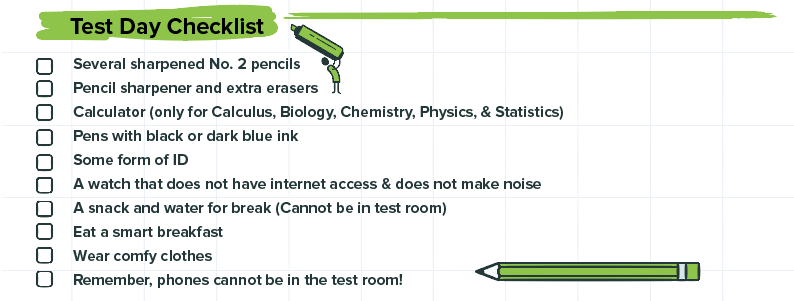
ii. Watch your time and prioritize finishing the exam completely.
If you get stuck on a problem, skip information technology and come back to it afterward. Give yourself time checks to go through each part of the examination, budgeting an actress 20 minutes at the end to cheque over your piece of work, clarify explanations, and terminate missing issues.
3. If y'all cannot do question (a) of a multi-role free response question, no worries! You lot can brand upwards a value and use that for subsequent parts,
or explain what your process would exist had you successfully answered office (a).
Recall, the exam graders assess your work holistically and are looking for areas to give y'all credit. If you can clearly communicate your thinking, you volition be fine.
four. Beware of these common mistakes in statistics:
- Confusing blocking (used to assign treatments) and stratifying (used to collect a sample)
- Stating that a claim is either correct or wrong, rather than citing prove that supports the claim
- Adding standard deviations instead of adding variances when combining random variables
- Forgetting to use the words "predicted" or "on average" when interpreting slope of a regression model
- Confusing confidence levels (the proportion of successful capture) with confidence intervals (the lower and upper bounds of an judge)
- Mixing up Blazon I and Type Ii Errors
- Forgetting to label axes and graphs
You don't need to memorize all of these, only y'all should know which ones you lot tend to skid upwards on from previous practise tests. Go on them in heed at the first of the exam and, in one case the exam begins, jot them down on a piece of bit paper for future reference.
v. Eat a good breakfast and relax!
Other than some calorie-free review with flashcards, you lot should avoid heavy studying and practise what y'all can to put your heed at ease on the forenoon of test day. Mimic an athlete the 24-hour interval of a large race or game. Practise some light stretches, swallow a good for you breakfast, pump yourself up with positive messaging, and trust that your preparation will pay off come game fourth dimension.
Return to the Table of Contents
AP® Statistics Review Notes and Practice Examination Resource
Here are our favorite online resources to help you prep for the AP® Statistics Exam:
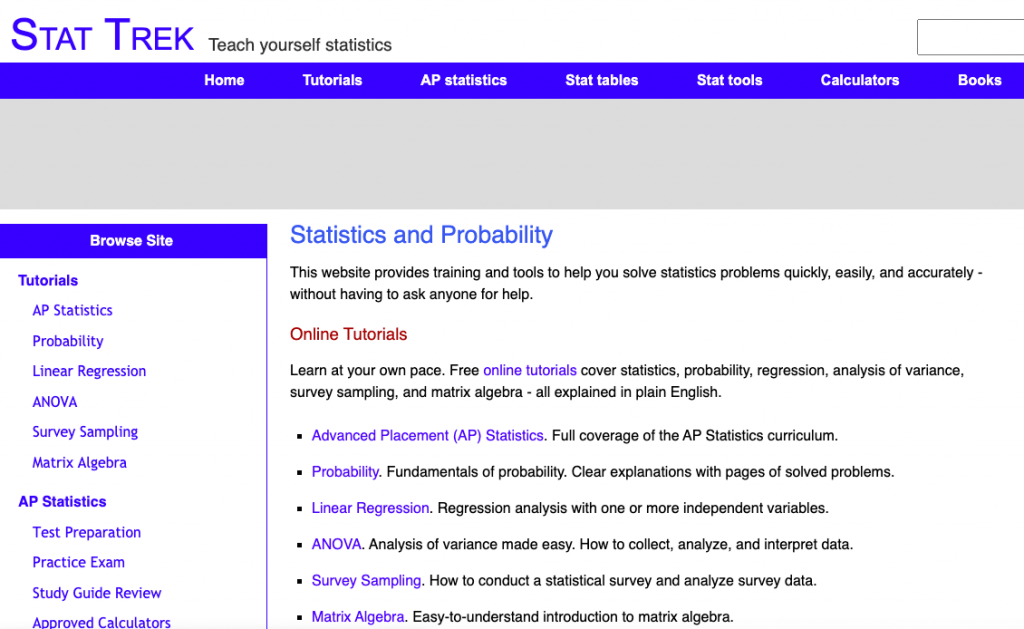
StatTrek
This website was founded by Harvey Berman, a business leader who left the corporate world to develop an educational website that teaches people statistics… for gratis! It is a 1 stop shop for about everything y'all need to acquire statistics, acting every bit an online textbook for those who might non take admission to a concrete textbook or in-classroom resources.
- Use this site if: y'all accept yet to acquire the AP® Stats material in a classroom setting and need the tools to learn independently on a budget. It includes online tutorials of the full AP® Statistics curriculum, practice questions, and online calculators with statistical functions.
- Don't use this site if: you are looking for a larger bank of practice problems that mimic the format of the AP® Stats Exam.
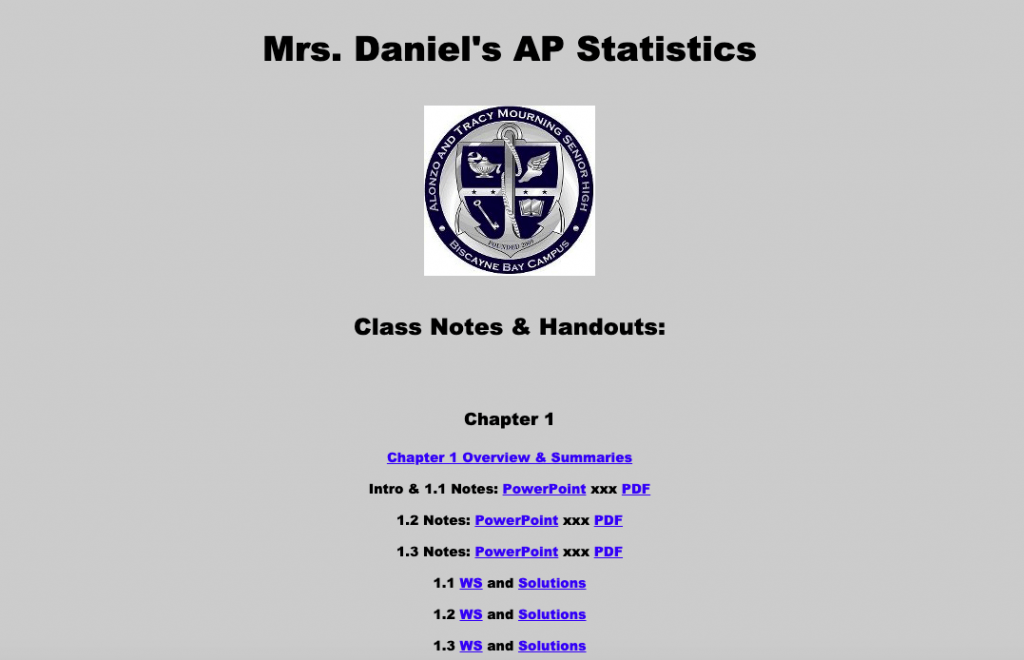
Mrs. Daniel's AP® Statistics
This site is created by a veteran AP® Statistics instructor, Stephanie Daniel, in the Miami-Dade County Public Schools district. Her materials include notes, powerpoints, worksheets (with accompanying solutions), and free-response questions for that topic.
- Use this site if: you desire exercise problems and review materials organized by topic. It is especially helpful if you use the pop textbook The Practise of Statistics (4th edition) and want accompanying resources.
- Don't use this site if: you want to learn statistical concepts from scratch with lectures or videos. Mrs. Daniel has detailed powerpoints and fill-in-the-blank notes, but without a guiding instructor to provide feedback, it can be difficult to learn on your ain.
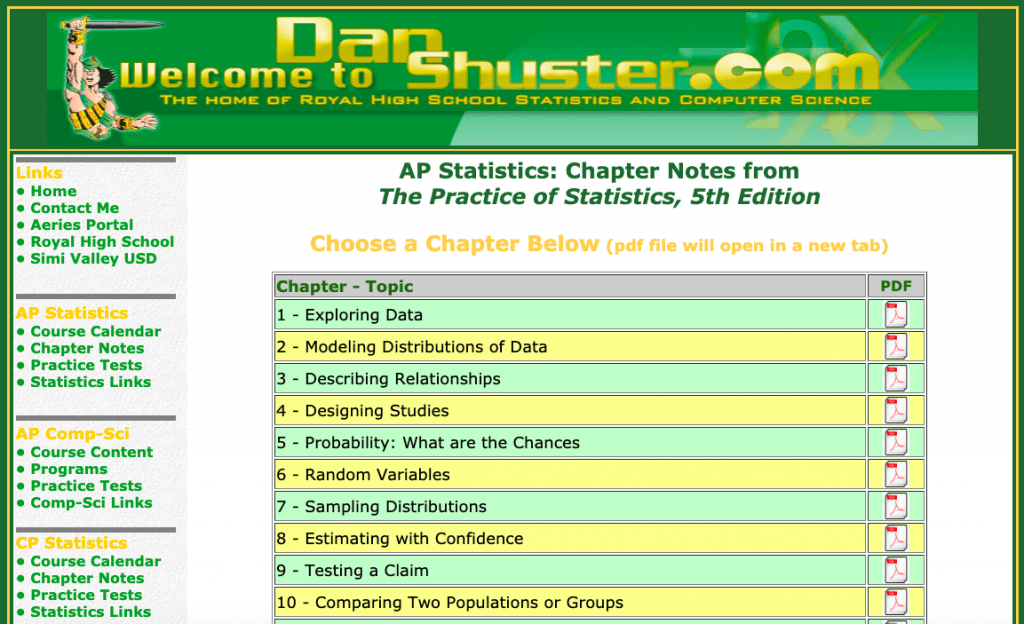
Dan Shuster
This site is created by a high schoolhouse math teacher from Simi Valley, CA and provides curtailed summary notes + practice problems for each unit. In add-on to AP® Statistics, his site contains materials for Algebra, Geometry, AP® Calculator Science, and other math courses.
- Use this site if: you want to scan through the master points for each unit and dive into practise material (both Multiple Choice and Free Response Questions) for those topics.
- Don't employ this site if: y'all need more than thorough explanations and feedback for the practice problems. The summary notes are essentially cheat sheets and reminders about big ideas, and the solution keys don't provide extra commentary.
Return to the Tabular array of Contents
Summary: The Best AP® Statistics Review Guide
Nosotros've covered a lot near how you tin prepare for the AP® Statistics Exam and be confident in your skills. To wrap information technology all upwardly, hither's a curtailed version of our written report plan outlined above.
- The AP® Statistics Exam has ii parts and will take 3 hours full.
The examination covers topics from the following units:
- Unit one: Exploring One-Variable Information
- Unit of measurement ii: Exploring Two-Variable Data
- Unit of measurement 3: Collecting Information
- Unit 4: Probability, Random Variables, and Probability Distributions
- Unit of measurement 5: Sampling Distributions
- Unit 6: Inference for Categorical Data: Proportions
- Unit 7: Inference for Quantitative Data: Means
- Unit of measurement 8: Inference for Categorical Data: Chi-Foursquare
- Unit ix: Inference for Quantitative Data: Slopes
For more particular on each topic, run into AP® Statistics: Course and Exam Description .
How to study for AP® Statistics: vii Steps
- Take a full diagnostic exam
- Identify topics that desire to prioritize for practice
- Map out your report sessions in a calendar
- Learn and review concepts with notes or videos
- Practice a LOT of practice bug and become feedback on right + wrong answers
- Take another total exam under time pressure to practice pacing
- Relax the twenty-four hours earlier the exam
Best Tips for AP® Statistics:
- Know the language of statistics and employ common phrases similar "on average", "predicted increase", or "sufficient testify to turn down the cypher". Employ the handout: Peak 10 Phrases to employ in your Answers for AP® Statistics
- Practice identifying binomial variables : ane) repeated trials, 2) two possible outcomes, three) a fixed probability of success, and 4) independent trials. Once you recognize it, you can quickly calculate probabilities using binompdf your calculator.
- Practice classifying statistical inference procedures using this applet on Classifying Statistics Issues , supplementing that with the article Proper noun that Significance and the visual flowchart of inference
- When completing the Complimentary Response section… exercise the easiest trouble first, and so the Investigative Job, and so the other 4 questions. That manner you don't run out of time tackling the hardest (and most valuable) problem on the test.
- Do, practice, practice! Nosotros tin can't say this oft enough. As presently as possible, showtime doing loftier-quality and challenging practice questions from College Board , Albert , or AP® Statistics Review Books .
We hope y'all take found this review guide helpful. If you follow the advice in this article and walk into the examination with a positive attitude, we are 100% confident that you lot will be happy with your score. Adept luck!
Source: https://www.albert.io/blog/ap-statistics-review/
0 Response to "Ap Statistics Unit 1 Test Review Problems Day 1"
Post a Comment